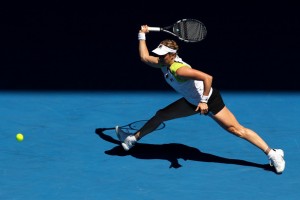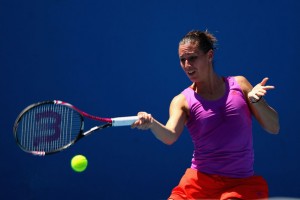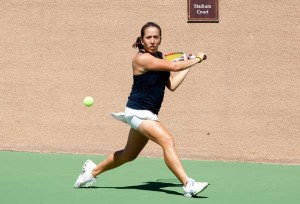By Jane Voigt, owner of DownTheTee.com
Statistics follow Venus Williams like baby ducks after their mother. Five Wimbledon titles and two U. S. Open titles. Those are only the majors ones, though. And to think she didn’t choose her fate, her destiny which makes up chapters in tennis history annals.
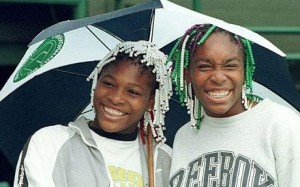
The Beginning
Richard Williams, Venus’s father, had an idea. He would turn his girls into tennis stars. They made good incomes and the challenge didn’t seem that steep. If he learned as much as he could about the game and teach it to Venus and Serena his live would be abundantly full of satisfaction and, well, money. Their fates, too, would be in the hand of providence, which was really at the heart of the target for Mr. Williams — a man who makes no qualms about his love of ‘his God Jehovah.’
The route constructed by Mr. Williams, as well as Oracene Price, Venus’s mother, was indeed unconventional when compared to the map designed by the USTA Junior Development and big tennis academies. They ran on formulas while Williams’s fuel was primarily empirical.
When Venus came to light on the WTA Tour in 1997 the tennis training choices made by Mr. Williams’ were questioned and often maligned. Commentators were astounded by Venus’s power and confidence in delivering that type of tennis normally associated with the men’s game.
Tennis took note of Venus’s run to the finals of her first major at the U. S. Open in 1997. She faced the No. 1 seed and No. 1 player in the world, Martina Hingis. Venus lost 60 64, yet her presence and potential power to influence tennis was duly recognized. Venus ended the year ranked No. 22; she began it ranked No. 110.
Achievements
Venus Williams’s special home is Wimbledon. She came alive there. And her game in 2000 was perfectly suited for the lawns, which were quicker than today’s.
At six-foot-one Venus moved quickly to the rhythm grass. Her hands followed suit, connecting with low balls out in front of her, volleys no one else seemed to reach and swinging volleys, those hard-to-time swats that accentuated her long legs and arms. She flew toward the ball the way Michael Jordan floated to the basket.
The speed of the the grass exhilarated her mind, too, which triggered her long-legged pursuit of the ball. She hoisted her first Venus Rosewater Platter that year at the downfall of Lindsay Davenport. Venus leaped and leaped in the air, holding onto that lovely platter, that symbol of the height of tennis accomplishment as if it were a trinket — her golden trinket of great worth and sentiment to a woman who would raise four more.
This first major title for Venus had followed on the heels of her little sister, Serena, who had captured the U. S. Open, her first slam, in 1999. As the elder sibling, Venus led and taught and protected her younger sister. She also was expected to have made the initial foray in Grand Slams. But she didn’t. She never publicly mentioned the order in which they won their titles; that’s not Venus. Yet her determination to win and win at Wimbledon was a clear sign that the grass of Wimbledon was hers alone. At least until this year when Serena equaled the mark set by her much-admired elder sister. And instead of embarrassment and shame for not having won six or even seven crowns, Venus displayed pride.
Venus Williams has battled for over 15 years on hard courts, red and green clay courts, and grass courts. She has earned 43 career singles titles, 22 doubles titles aside sister Serena, one singles gold medal, and three doubles gold medals. Thirteen of her doubles titles were won in 13 finals — a perfect record.
The Future
Venus Williams’s future was, again, something she didn’t choose or expect or want in her life. But in early September during the 2011 U. S. Open after her second-round loss to Sabine Lisicki, Venus “could not raise her serving arm,” Karen Crouse of The New York Times wrote.
Williams withdrew from the tournament and announced “that she was suffering from fatigue and other symptoms related to Sjogren’s Syndrome,” wrote Tara Parker-Pope also of The New York Times.
The symptoms of dry eyes, aching joints, and exhaustion had followed her around for years, before the diagnosis of this chronic autoimmune disease was made. The worse part … she never knew how she would feel on any given day, even if that day was during a major tournament.
Instead of grief and discouragement, Venus treated her new life with hope. She felt a sense of relief after the diagnosis, too. It could lay a foundation for recovery, and has.
She has lost some weight, doesn’t eat meat, and remains the most dangerous floater in any draw. The dangerous floater label probably makes her smile, at least to herself. She doesn’t plan to give up her tennis career, even as she succeeds at ventures in the ‘real world,’ for example her tennis line of clothing called Eleven.
Favorite
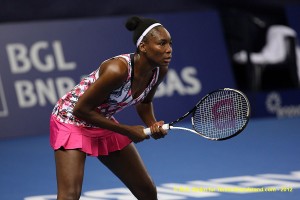
The titles are part of it, the attraction to Venus as a favorite player. The favorite player. But they don’t rank at the top of the list, as if she could be dispensed as a column of attributes. Venus is athleticism made for athletes. She is even in her temperament, fair, and childlike at times. She giggles. She directs the ball, her life in a manner that pulls you in to her. We sympathize with her trials. When she talks, answering questions with some meat to them, she is thoughtful and authentic. She has her days, too, when annoyance prompts an appropriate quip in response to silly questions from the press.
Toronto, Rogers Cup, 2010. Question: When did you know you’d lost the match, Venus?
Answer: When I shook her hand at the net.
Venus Williams stands on the shoulders of Arthur Ashe, the first U. S. Open men’s singles champion in 1968 — the beginning of The Open Era. Zina Garrison was probably the first black woman tennis player that spurred on Venus, as did Althea Gibson. And there is Billy Jean King, another Californian, that Venus emulates and appreciates openly.
Finally, her sense of family and love within a family, and that which was given to her by her parents no matter how far flung some methods were thought to be and no matter the fervor they have evoked for situations still unclear to most, makes her a favorite. Along with those wild swinging forehand volleys on the full stretch. There’s nothing that beats that on a tennis court.
Jane Voigt lives, breathes and writes tennis. She wrote about John Isner’s ground-breaking wildcard run at the formerly named Legg Mason Tennis Classic in 2007 for Tennis.com. She has written tennis commentary for the late, great Tennis Week print publication and online version. Hundreds of articles from Jane have been seen on TennisServer.com, too. She now maintains her own website at DownTheTee.com, and has traveled throughout the U. S. and Canada to cover tournaments. Ask her to play tennis, and she’ll prefer singles to doubles.

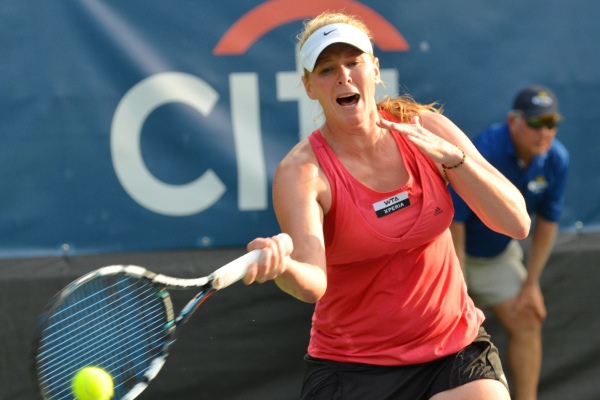 Lindsay Lee-Waters – Photo by Romana Cvitkovic
Lindsay Lee-Waters – Photo by Romana Cvitkovic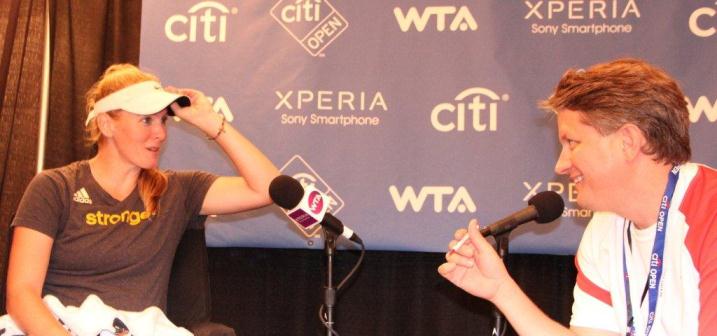 Lindsay Lee-Waters (Left) and Christopher Lancette – Photo by Won-ok Kim.
Lindsay Lee-Waters (Left) and Christopher Lancette – Photo by Won-ok Kim.
